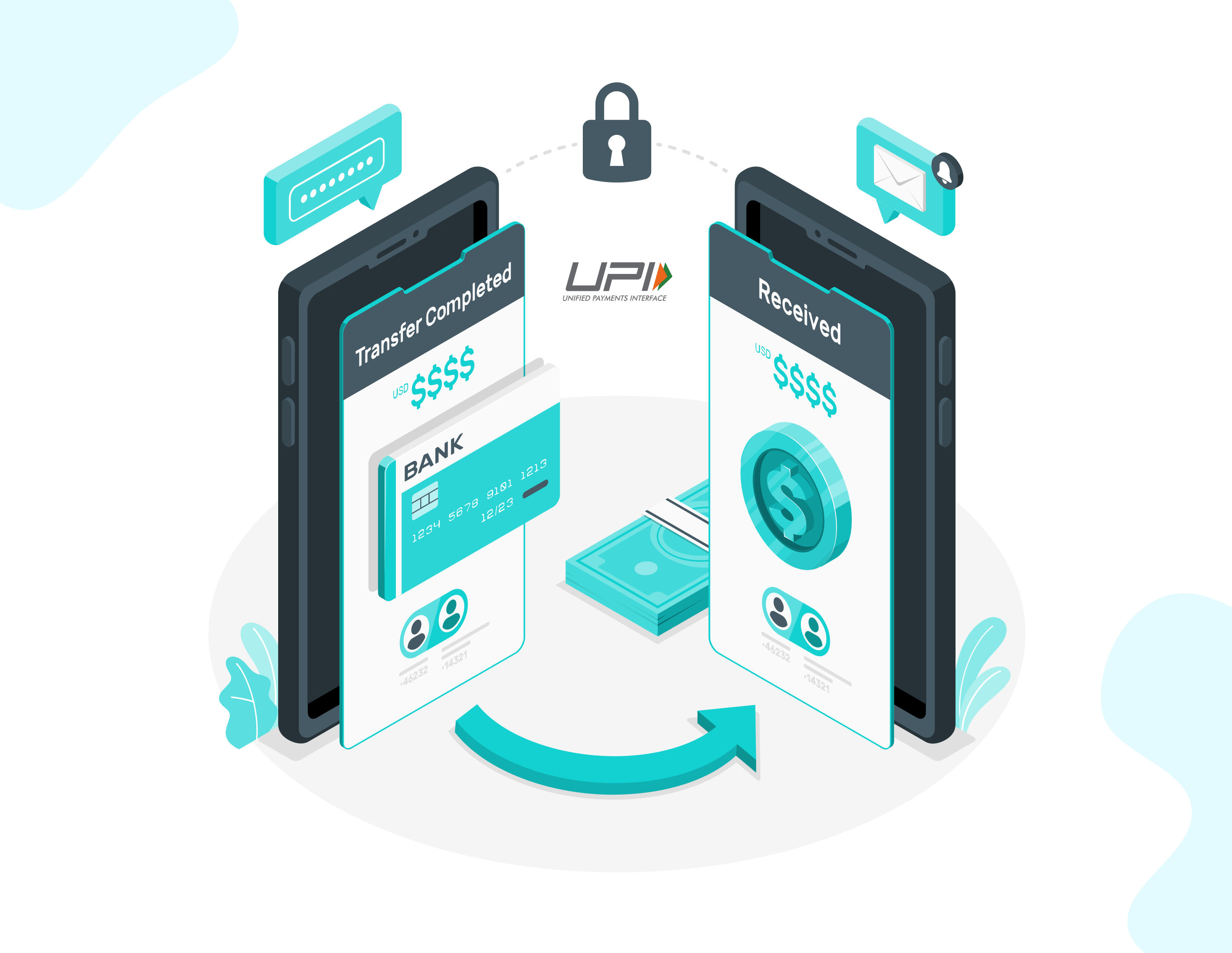Everything You Need to Know about Unified Payments Interface (UPI): A Complete Guide
As a digital business owner or merchant, you must've heard of UPI and seen UPI QR codes at local shops. But what exactly is UPI, and why is it getting so much attention? Well, this blog answers this question and a lot more.

This comprehensive guide discusses what UPI is, how it works, how it's different from other payment systems such as IMPS, NEFT, and RTGS, which industries use UPI, and the advantages it brings along. So, read in full.
What is UPI?
UPI stands for United Payments interface, an instant, robust, real-time payment system crafted by the prestigious Indian organization NPCI, known for making digital payments accessible in India.
UPI was initially launched with 21 member banks on 11th April 2016 by Raghuram G Rajan, Governor, RBI. And as you'd have guessed, it was a huge success. So much so that several banks across the country started launching UPI-enabled applications on the Google Play Store.
Fast forward to today, UPI is the fastest-growing payment method among Indian consumers and is also gaining popularity on the global stage. Users can send or receive payments using their mobile number or virtual payment address (VPA or a UPI ID.)
The value of UPI transactions grew from Rs. 48 crore in October 2016 to a whopping 12 lakh crore in October 2022. Just six years after its launch, UPI accounts for 16% of the total retail payments.
How Does UPI Work?

In the most basic terms, a person creates a UPI id linked to their bank account. Using this UPI id, that person can receive money directly in their bank account and send money to someone's bank account. This is an oversimplified version of how UPI works. However, to understand the working of UPI, you need to know what all parties are involved in a UPI transaction:
1) Payment Service Providers
PSPs are applications that allow users to initiate or complete payments or financial transactions. Common examples are Paytm, Google Pay, PhonePe, etc.
Using such applications, customers can create their unique UPI ids connected to their banks and send or receive money using the same. Customers no longer need to rely on traditional banking apps to send or receive money.
2) NPCI
NPCI stands for National Payments Corporation of India. It's a not-for-profit organization that connects payment service providers and banks seamlessly. The primary role of NPCI here is to ensure that the data flow between payments apps and banks is routed to verified destinations. Because of NPCI, customers can link their bank accounts and send & accept payments using any UPI application.
3) Sender's Bank or Issuing Bank
In UPI payments, the money is transferred from the sender's bank account to the receiver's bank account. The issuing bank debits the money from the customer's account based on NPCI's request and then sends a notification to NPCI once the money is debited successfully.
4) Receiver's Bank or Acquiring Bank
As you'd have already guessed, the receiver's bank is here to accept/credit the money sent by the issuing bank based on NPCI's request. And once that transfer is successfully made, the receiver's bank responds to NPCI confirming the transaction.
5) Payee PSP
Payee PSP is the payment gateway the merchant uses in case a transaction is made between a person and a merchant (person-to-merchant or P2M).
How Is UPI Unique?
Hands down, UPI is unique and emerging as a preferred payment route in India and outside India. There are a few notable factors that make this payment model unique and trustworthy, which are:
- UPI continues to avoid reliance on any individual bank as a centralized facility. Its consistency and ability to work on different financial apps make it an easy-to-use payment tool.
- Its security, simplicity, and instantaneous payment features add to its usage model.
- Since the entire UPI model is built on top of the Immediate Payment Service (IMPS) structure, payments are immediate and quick. They can be made from one UPI ID to another without incurring the need to add the recipient's bank details.
- UPI's connectivity spreads over 300 banks, relatively quickly connecting urban and rural areas.
- Finally, the entire UPI model promotes a cashless economy, which puts a lot of power in the hands of the everyday consumer.
How is UPI different from IMPS, RTGS, and NEFT?
Here's how:
1. UPI vs. IMPS
IMPS stands for Immediate Payment Service. While IMPS is also known for real-time transfers, its registration time is quite high. Also, once the registration is done, the user has to enter the name, account number, IFSC code, and similar details to send money which usually takes more time than UPI.
UPI, on the other hand, is way more convenient. Users need to enter the receiver's UPI ID to send the money, which will instantly reflect in the receiver's account.
2. UPI vs. RTGS
RTGS stands for Real Time Gross Settlement. This method is known for transferring vast amounts as the minimum amount that can be transferred using RTGS is Rs. 2 Lakh. However, there isn't an upper limit. The transfers made using RTGS are instant but work only from 8:00 AM to 4:30 Monday to Saturday (except the 4th and 2nd Saturday.)
While there is no lower limit for UPI transfers, there is an upper limit. For instance, you can send as low as Re. 1 and as high as Rs. 100,000 daily. Also, UPI works all days of the year and at all times of the day.
3. UPI vs. NEFT
NEFT stands for National Electronics Funds Transfer. This payment system has no maximum or minimum transfer limit. Customers can use NEFT on their mobile banking apps, internet banking, and even at bank branches. However, NEFT transactions work from 8.00 AM to 6.30 PM from Monday to Saturday (except the 4th and 2nd Saturday). Also, the transfers can take anywhere from 2 hours to 1 business day as they're processed in batches.
UPI payments, as stated earlier, have a maximum limit of 1 Lakh per day, unlike NEFT. However, UPI payments are faster, instantaneous, and can be processed any day of the year, regardless of the time.
Good read: What is UPI Lite?
Major Industries Dominated by UPI
Here are some common industries that extensively rely on UPI infrastructure for payments:
1) eCommerce

The eCommerce industry is all about catering to customer needs. And as UPI payments offer a lot of convenience to customers, eCommerce merchants rely extensively on UPI infrastructure for accepting payments.
For instance, online and offline merchants can collect customer payments using UPI ID or QR codes. This makes the COD payments easy in case the customer wants to avoid paying cash.
Moreover, eCommerce merchants who use a subscription-based model can use UPI to set up recurring payments. Also, processing refunds becomes more effortless and instantaneous, which improves customer experience.
Furthermore, merchants can keep track of all their UPI payments from a single dashboard that the payment gateway offers.
2) Education

The education sector is also leveraging the benefits offered by the UPI infrastructure. Educational institutes such as colleges and schools use UPI to accept student donations and fees. This way, parents can skip visiting banks to initiate fee payments. They can quickly pay the fee from their mobile phones. And the authorities can use the payment gateway dashboard to access all the payments allowing easy management.
3) Travel

Often, while traveling, people run out of cash. And it takes a lot of work to find ATMs, especially when the area is remote. However, UPI makes it easy. Almost all shops, vendors, tourist guides, etc., at tourist destinations in India use UPI payments, making travelers convenient.
Moreover, NPCI's international organization NIPL has partnered with Worldline. This partnership allows Indian travelers to use UPI for payments throughout Europe using their mobile phones, allowing easy access to travelers.
Types of UPI Payment Flow?
Here are the two types of payment flows UPI offers:
1. UPI Intent Flow
In the UPI Intent flow, the customer can choose from a list of pre-installed UPI applications from their device. Once they choose the app, the customer needs to add a 4/6 digit UPI pin, and the money is transferred to the recipient or merchant.
2. UPI Collect Flow
In UPI Collect Flow, the customers first enter their VPA or UPI Id. This ID is verified, and if it's correct, a collect notification is sent to the customer, using which they can make the payment. Here's how generally, payment can be collected from customers:
- Payment Collection via UPI Payment Link
In this method, merchants can simply create a payment link and share the same with the customers via SMS, email, or WhatsApp. You need to select the amount and create the payment link for your customers. The customers can then make the payment directly into your account.
- Payment Collection via In-app UPI Payments
In this method, merchants integrate UPI into their own applications. This way, customers can make the payment directly from their mobile while shopping, enabling a seamless and faster checkout experience.
- Payment Collection via QR Code
As the name says, a QR code is used for accepting payments. The merchants can easily create a one-time static QR code wherein the consumer can scan it, enter the amount, and make the payment. Or they can create a dynamic QR code wherein the payment information changes each time. In this case, the payment amount is auto-filled. The consumer needs to scan the code, enter the pin, and It's done.
The QR code method is suitable for both online and offline merchants. Online merchants usually use a dynamic QR, while offline ones have a static QR code printed on paper.
Benefits of Using UPI Payment for Businesses
UPI payments bring numerous benefits to businesses. Here are some of them:
1. Faster Settlement Cycles
One of the most significant advantages of using UPI for businesses is the short settlement cycles. Unlike other payment methods that usually take 2-3 business days before crediting the amount in the merchant's account, with UPI, merchants can access their money way faster.
Please note: While settlement cycles with UPI are faster, the time taken for the money to reflect in your (merchant) account varies with the payment gateway you're using. You may get access to your funds within 15 minutes, or it could even take 1-2 business days. Nevertheless, it's faster than credit cards.
2. High Transaction Limits
The National Payments Corporation of India (NPCI) has set the limit for UPI transactions at Rs. 1 lakh per transaction. While the P2P or peer-to-peer transactions are limited to 10 transactions per day, the limit doesn't apply to P2M or peer-to-merchant transactions. It means merchants can accept any number of payments, making it easy for businesses that experience high transaction volume.
Also, the aforementioned UPI limits only apply if you aren't using a payment gateway. If you've integrated a payment gateway on your website, you can accept any number of transactions of any value. However, this limit can be modified by payment gateways.
3. Lower Transaction Fees
Payment gateways undoubtedly make the lives of merchants very easy. You need not maintain much documentation or reconcile the invoices, as the payment gateway does that for you. However, in return, all payment gateways charge you a fee for every transaction.
The amount charged by the payment gateway depends on what payment mode the customer chooses. And guess what? UPI payments have the lowest merchant discount rate or fee. This way, if your customers choose UPI to make payments, you'll save money.
Note: While there is no transaction fee in UPI, a platform risk fee is charged by the merchant for managing disputes, refunds, and settlements.
3. Lower Transaction Fees
Reconciliation is essential for accurate record-keeping and spotting errors. However, it's difficult to manage if the payments come from multiple modes. Fortunately, UPI payments, similar to other payment modes, can be easily handled by your payment gateway. You can simply visit the payment gateway's dashboard and track all your settlements there, making reconciliation easy.
How Can inai Help?
Now that you know how advantageous UPI is for merchants, it's time to include it as a mode of payment. But how can you do that? Well, that's when inai comes into the picture.
inai is a payment aggregator that can help you connect with multiple payment gateways and make 300+ payment methods available to your customers across the globe. And with our new UPI integration, you can also offer UPI as the mode of payment.
With inai, you can manage payments, refunds, and chargebacks and even set up UPI for recurring payments. In addition, our system helps you route the transaction through the most affordable payment gateway saving you money.
The best part? You need not hire a developer to integrate UPI payments. inai offers codeless integration using which you can add a UPI payment method on your checkout page on your mobile app or even website.







Let’s get started








.png?width=123&height=71&name=inai%20logo%20-%20dark%201(1).png)
.png?width=4068&height=1080&name=CTA%20(3).png)